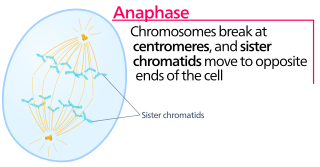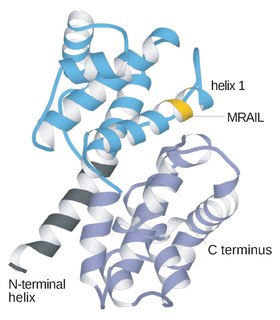Related Research Articles

In cell biology, mitosis is a part of the cell cycle in which replicated chromosomes are separated into two new nuclei. Cell division gives rise to genetically identical cells in which the total number of chromosomes is maintained. Therefore, the mitosis is also known as equational division. In general, mitosis is preceded by the S stage of interphase and is often followed by telophase and cytokinesis; which divides the cytoplasm, organelles and cell membrane of one cell into two new cells containing roughly equal shares of these cellular components. The different stages of Mitosis altogether define the mitotic (M) phase of an animal cell cycle—the division of the mother cell into two daughter cells genetically identical to each other.

Anaphase, is the stage of mitosis after the process of metaphase, when replicated chromosomes are split and the newly-copied chromosomes are moved to opposite poles of the cell. Chromosomes also reach their overall maximum condensation in late anaphase, to help chromosome segregation and the re-formation of the nucleus.

In cell biology, the spindle apparatus refers to the cytoskeletal structure of eukaryotic cells that forms during cell division to separate sister chromatids between daughter cells. It is referred to as the mitotic spindle during mitosis, a process that produces genetically identical daughter cells, or the meiotic spindle during meiosis, a process that produces gametes with half the number of chromosomes of the parent cell.

Cyclin is a family of proteins that controls the progression of a cell through the cell cycle by activating cyclin-dependent kinase (CDK) enzymes or group of enzymes required for synthesis of cell cycle.

The spindle checkpoint, also known as the metaphase-to-anaphase transition, the spindle assembly checkpoint (SAC), or the mitotic checkpoint, is a cell cycle checkpoint during mitosis or meiosis that prevents the separation of the duplicated chromosomes (anaphase) until each chromosome is properly attached to the spindle. To achieve proper segregation, the two kinetochores on the sister chromatids must be attached to opposite spindle poles. Only this pattern of attachment will ensure that each daughter cell receives one copy of the chromosome. The defining biochemical feature of this checkpoint is the stimulation of the anaphase-promoting complex by M-phase cyclin-CDK complexes, which in turn causes the proteolytic destruction of cyclins and proteins that hold the sister chromatids together.

A kinetochore is a disc-shaped protein structure associated with duplicated chromatids in eukaryotic cells where the spindle fibers attach during cell division to pull sister chromatids apart. The kinetochore assembles on the centromere and links the chromosome to microtubule polymers from the mitotic spindle during mitosis and meiosis. Its proteins also help to hold the sister chromatids together and play a role in chromosome editing. Details of the specific areas of origin are unknown.
Mad2 is an essential spindle checkpoint protein. The spindle checkpoint system is a regulatory system that restrains progression through the metaphase-to-anaphase transition. The Mad2 gene was first identified in the yeast S. cerevisiae in a screen for genes which when mutated would confer sensitivity to microtubule poisons. The human orthologues of Mad2 were first cloned in a search for human cDNAs that would rescue the microtubule poison-sensitivity of a yeast strain in which a kinetochore binding protein was missing. The protein was shown to be present at unattached kinetochores and antibody inhibition studies demonstrated it was essential to execute a block in the metaphase-to-anaphase transition in response to the microtubule poison nocodazole. Subsequent cloning of the Xenopus laevis orthologue, facilitated by the sharing of the human sequence, allowed for the characterization of the mitotic checkpoint in egg extracts.

Aurora B kinase is a protein that functions in the attachment of the mitotic spindle to the centromere.
Anaphase lag is a consequence of an event during cell division where sister chromatids do not properly separate from each other because of improper spindle formation. The chromosome or chromatid does not properly migrate during anaphase and the daughter cells will lose some genetic information. It is one of many causes of aneuploidy. This event can occur during both meiosis and mitosis with unique repercussions. In either case, anaphase lag will cause one daughter cell to receive a complete set of chromosomes while the other lacks one paired set of chromosomes, creating a form of monosomy. Whether the cell survives depends on which sister chromatid was lost and the background genomic state of the cell. The passage of abnormal numbers of chromosomes will have unique consequences with regards to mosaicism and development as well as the progression and heterogeneity of cancers.

Serine/threonine-protein kinase PLK1, also known as polo-like kinase 1 (PLK-1) or serine/threonine-protein kinase 13 (STPK13), is an enzyme that in humans is encoded by the PLK1 gene.

The cell division cycle protein 20 homolog is an essential regulator of cell division that is encoded by the CDC20 gene in humans. To the best of current knowledge its most important function is to activate the anaphase promoting complex (APC/C), a large 11-13 subunit complex that initiates chromatid separation and entrance into anaphase. The APC/CCdc20 protein complex has two main downstream targets. Firstly, it targets securin for destruction, enabling the eventual destruction of cohesin and thus sister chromatid separation. It also targets S and M-phase (S/M) cyclins for destruction, which inactivates S/M cyclin-dependent kinases (Cdks) and allows the cell to exit from mitosis. A closely related protein, Cdc20homologue-1 (Cdh1) plays a complementary role in the cell cycle.

Mitotic checkpoint serine/threonine-protein kinase BUB1 also known as BUB1 is an enzyme that in humans is encoded by the BUB1 gene.

Mitotic checkpoint serine/threonine-protein kinase BUB1 beta is an enzyme that in humans is encoded by the BUB1B gene.

Cell division cycle protein 27 homolog is a protein that in humans is encoded by the CDC27 gene.

Centromere protein F is a protein that in humans is encoded by the CENPF gene. It is involved in chromosome segregation during cell division. It also has a role in the orientation of microtubules to form cellular cilia.

Cell division cycle protein 16 homolog is a protein that in humans is encoded by the CDC16 gene.

Mitotic checkpoint protein BUB3 is a protein that in humans is encoded by the BUB3 gene.

Serine/threonine-protein kinase 13 is an enzyme that in humans is encoded by the AURKC gene.

Mad1 is a non-essential protein which in yeast has a function in the spindle assembly checkpoint (SAC). This checkpoint monitors chromosome attachment to spindle microtubules and prevents cells from starting anaphase until the spindle is built up. The name Mad refers to the observation that mutant cells are mitotic arrest deficient (MAD) during microtubule depolymerization. Mad1 recruits the anaphase inhibitor Mad2 to unattached kinetochores and is essential for Mad2-Cdc20 complex formation in vivo but not in vitro. In vivo, Mad1 acts as a competitive inhibitor of the Mad2-Cdc20 complex. Mad1 is phosphorylated by Mps1 which then leads together with other activities to the formation of the mitotic checkpoint complex (MCC). Thereby it inhibits the activity of the anaphase-promoting complex/cyclosome (APC/C). Homologs of Mad1 are conserved in eukaryotes from yeast to mammals.
J. Richard McIntosh is a Distinguished Professor Emeritus in Molecular, Cellular, and Developmental Biology at the University of Colorado Boulder. McIntosh first graduated from Harvard with a BA in Physics in 1961, and again with a Ph.D. in Biophysics in 1968. He began his teaching career at Harvard but has spent most of his career at the University of Colorado Boulder. At the University of Colorado Boulder, McIntosh taught biology courses at both the undergraduate and graduate levels. Additionally, he created an undergraduate course in the biology of cancer towards the last several years of his teaching career. McIntosh's research career looks at a variety of things, including different parts of mitosis, microtubules, and motor proteins.
References
- ↑ "SKA2". Entrez Gene . Retrieved 3 Aug 2014.
- 1 2 3 4 5 6 7 8 9 10 Hanisch A, Silljé HH, Nigg EA (November 2006). "Timely anaphase onset requires a novel spindle and kinetochore complex comprising Ska1 and Ska2". The EMBO Journal. 25 (23): 5504–15. doi:10.1038/sj.emboj.7601426. PMC 1679759 . PMID 17093495.
- 1 2 3 Wang Y, Zhang Y, Zhang C, Weng H, Li Y, Cai W, Xie M, Long Y, Ai Q, Liu Z, Du G, Wang S, Niu Y, Song F, Ozaki T, Bu Y (September 2015). "The gene pair PRR11 and SKA2 shares a NF-Y-regulated bidirectional promoter and contributes to lung cancer development". Biochimica et Biophysica Acta (BBA) - Gene Regulatory Mechanisms. 1849 (9): 1133–44. doi:10.1016/j.bbagrm.2015.07.002. PMID 26162986.
- 1 2 3 Guintivano J, Brown T, Newcomer A, Jones M, Cox O, Maher BS, Eaton WW, Payne JL, Wilcox HC, Kaminsky ZA (December 2014). "Identification and replication of a combined epigenetic and genetic biomarker predicting suicide and suicidal behaviors". The American Journal of Psychiatry. 171 (12): 1287–96. doi:10.1176/appi.ajp.2014.14010008. PMC 7081376 . PMID 25073599. S2CID 46235766.
- ↑ "Prototype blood test will assess for suicide risk in soldiers". The Independent (UK). 3 Aug 2014. Retrieved 3 Aug 2014.
- ↑ Gaitanos TN, Santamaria A, Jeyaprakash AA, Wang B, Conti E, Nigg EA (May 2009). "Stable kinetochore-microtubule interactions depend on the Ska complex and its new component Ska3/C13Orf3". The EMBO Journal. 28 (10): 1442–52. doi:10.1038/emboj.2009.96. PMC 2669960 . PMID 19360002.
- ↑ Jeyaprakash AA, Santamaria A, Jayachandran U, Chan YW, Benda C, Nigg EA, Conti E (May 2012). "Structural and functional organization of the Ska complex, a key component of the kinetochore-microtubule interface". Molecular Cell. 46 (3): 274–86. doi: 10.1016/j.molcel.2012.03.005 . PMID 22483620.
- 1 2 Welburn JP, Grishchuk EL, Backer CB, Wilson-Kubalek EM, Yates JR, Cheeseman IM (March 2009). "The human kinetochore Ska1 complex facilitates microtubule depolymerization-coupled motility". Developmental Cell. 16 (3): 374–85. doi:10.1016/j.devcel.2009.01.011. PMC 2746561 . PMID 19289083.
- 1 2 Schmidt JC, Arthanari H, Boeszoermenyi A, Dashkevich NM, Wilson-Kubalek EM, Monnier N, Markus M, Oberer M, Milligan RA, Bathe M, Wagner G, Grishchuk EL, Cheeseman IM (November 2012). "The kinetochore-bound Ska1 complex tracks depolymerizing microtubules and binds to curved protofilaments". Developmental Cell. 23 (5): 968–80. doi:10.1016/j.devcel.2012.09.012. PMC 3500403 . PMID 23085020.
- ↑ Rice L, Waters CE, Eccles J, Garside H, Sommer P, Kay P, Blackhall FH, Zeef L, Telfer B, Stratford I, Clarke R, Singh D, Stevens A, White A, Ray DW (September 2008). "Identification and functional analysis of SKA2 interaction with the glucocorticoid receptor". The Journal of Endocrinology. 198 (3): 499–509. doi:10.1677/joe-08-0019. PMC 2518725 . PMID 18583474.
- ↑ Wakano C, Byun JS, Di LJ, Gardner K (July 2012). "The dual lives of bidirectional promoters". Biochimica et Biophysica Acta (BBA) - Gene Regulatory Mechanisms. 1819 (7): 688–93. doi:10.1016/j.bbagrm.2012.02.006. PMC 3371153 . PMID 22366276.
- ↑ Orekhova AS, Rubtsov PM (April 2013). "Bidirectional promoters in the transcription of mammalian genomes". Biochemistry. Biokhimiia. 78 (4): 335–41. doi:10.1134/S0006297913040020. PMID 23590436. S2CID 18378130.
- ↑ Zhang C, Zhang Y, Li Y, Zhu H, Wang Y, Cai W, Zhu J, Ozaki T, Bu Y (March 2015). "PRR11 regulates late-S to G2/M phase progression and induces premature chromatin condensation (PCC)". Biochemical and Biophysical Research Communications. 458 (3): 501–8. doi:10.1016/j.bbrc.2015.01.139. PMID 25666944.
- ↑ Liu L, Nie J, Chen L, Dong G, Du X, Wu X, Tang Y, Han W (5 February 2013). "The oncogenic role of microRNA-130a/301a/454 in human colorectal cancer via targeting Smad4 expression". PLOS ONE. 8 (2): e55532. Bibcode:2013PLoSO...855532L. doi:10.1371/journal.pone.0055532. PMC 3564758 . PMID 23393589.